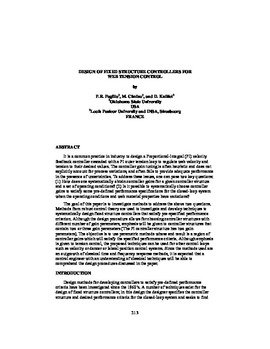| dc.contributor.author | Pagilla, P. R. | |
| dc.contributor.author | Cimino, M. | |
| dc.contributor.author | Knittel, D. | |
| dc.contributor.other | International Conference on Web Handling (2007) | |
| dc.date.accessioned | 2019-11-11T16:19:52Z | |
| dc.date.available | 2019-11-11T16:19:52Z | |
| dc.date.issued | 2007-06 | |
| dc.identifier | oksd_icwh_2007_pagilla2 | |
| dc.identifier.citation | Pagilla, P. R., Cimino, M., & Knittel, D. (2007, June). Design of fixed structure controllers for web tension control. Paper presented at the Ninth International Conference on Web Handling (IWEB), Stillwater, OK. | |
| dc.identifier.uri | https://hdl.handle.net/11244/321920 | |
| dc.description.abstract | It is a common practice in industry to design a Proportional-Integral (PI) velocity feedback controller cascaded with a PI outer tension loop to regulate web velocity and tension to their desired values. The controller gain tuning is often heuristic and does not explicitly account for process variations, and often fails to provide adequate performance in the presence of uncertainties. To address these issues, one can pose two key questions: (1) How does one systematically obtain controller gains for a given controller structure and a set of operating conditions? (2) Is it possible to systematically choose controller gains to satisfy some pre-defined performance specifications for the closed-loop system when the operating conditions and web material properties have variations? | |
| dc.description.abstract | The goal of this paper is to investigate methods to address the above two questions. Methods from robust control theory are used to investigate and develop techniques to systematically design fixed structure controllers that satisfy pre-specified performance criterion. Although the design procedure allows for choosing controller structures with different number of gain parameters, emphasis will be given to controller structures that contain two or three gain parameters (The PI controller structure has two gain parameters). The objective is to use parametric methods whose end result is a region of controller gains which will satisfy the specified performance criteria. Although emphasis is given to tension control, the proposed techniques can be used for other control loops such as velocity or dancer or lateral position control systems. Since the methods used are an outgrowth of classical time and frequency response methods, it is expected that a control engineer with an understanding of classical techniques will be able to comprehend the design procedures discussed in the paper. | |
| dc.format | application/pdf | |
| dc.language | en_US | |
| dc.publisher | Oklahoma State University | |
| dc.rights | In the Oklahoma State University Library's institutional repository this paper is made available through the open access principles and the terms of agreement/consent between the author(s) and the publisher. The permission policy on the use, reproduction or distribution of the article falls under fair use for educational, scholarship, and research purposes. Contact Digital Resources and Discovery Services at lib-dls@okstate.edu or 405-744-9161 for further information. | |
| dc.title | Design of fixed structure controllers for web tension control | |
| osu.filename | oksd_icwh_2007_pagilla2.pdf | |
| dc.description.department | Mechanical and Aerospace Engineering | |
| dc.type.genre | Conference proceedings | |
| dc.type.material | Text | |
